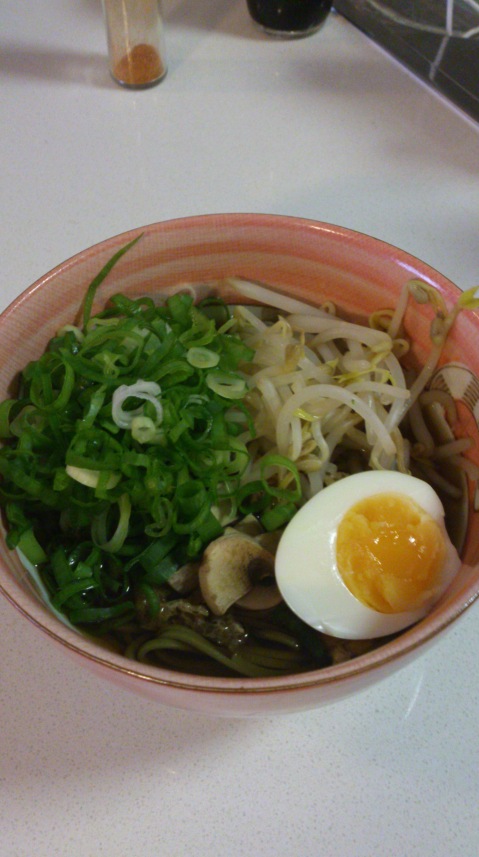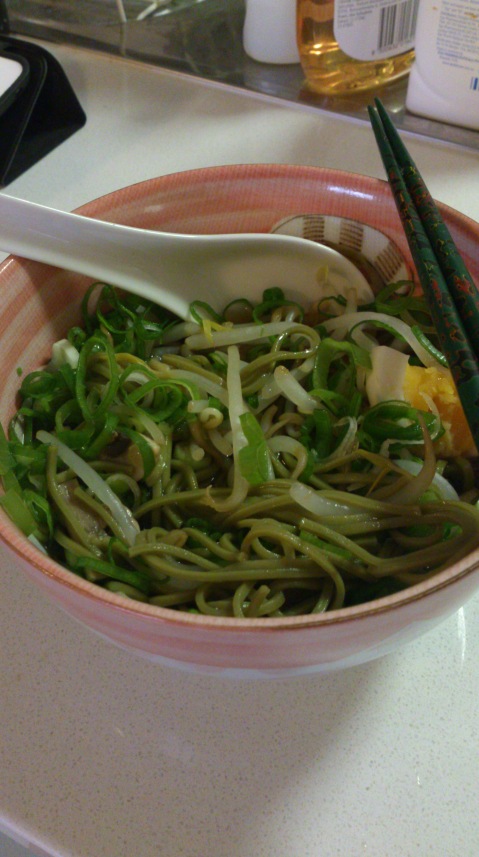I almost forgot to post, but for the sake of documentation, here is the soba with which we farewelled 2014.
We also finished off our Stella Bella Chardonnay (Margaret River) and joined the revelry in Northbridge Piazza. Time flies like an arrow.


I almost forgot to post, but for the sake of documentation, here is the soba with which we farewelled 2014.
We also finished off our Stella Bella Chardonnay (Margaret River) and joined the revelry in Northbridge Piazza. Time flies like an arrow.


Permalink Comments off
I’m having a hard time believing that it’s already time to adieu 2013. Well, I prefer even numbers, so I’m ready to get this show on the road.
To usher out the year properly, and to wish for long (but not thick) life, we followed the Japanese tradition of eating soba on New Year’s Eve.
As usual, the soba was dressed with a nice variety of toppings: natto, mashed avocado, eggs with slightly runny yolks, raw green onions, nori seaweed cut into strips, and of course, wasabi and tsuyu (soba sauce).
Fantastic.
[UPDATE: just a note about the eggs: they’re hot springs egg style (i.e., soft yolks). The key to this is to bring water to a boil FIRST, then add the eggs and cook for seven minutes.
Also, this wine.


New Year’s Eve rosé
Permalink Comments off

This was an unusual soba dish that I can only describe as nifty.
The original recipe focused on a ゆず / こしょう sauce (citrus/black pepper) and included bacon. Fortunately, Yusuke made modifications.
The soba (buckwheat noodles) was boiled as usual. The toppings were:
The sauce was assembled as follows:
Fresh minced garlic was sauteed with sesame oil until aromatic. Next came chopped tomatoes, cooked until heated. The liquid portion of the soba sauce was:
N.B. Soba must be slurped, loudly. I am slowly developing the technique.
Permalink Comments off

This dish was rather a nifty creation, in my opinion.
Yusuke’s first task was to boil fresh bean sprouts: just a few minutes to retain a crunchy texture.
Next, he halved cherry tomatoes, removed the seeds, and sautéed them in a dry frying pan (they had enough liquid alone).
He set the tomatoes aside and repeated the sautéing with asparagus spears, again in a dry pan.
After the veggies were done, he boiled soba in plain water for about 4 minutes. Longer leads to mushiness!
He arranged the drained noodles on a plate, topping the pile with neatly placed bean sprouts, tomatoes, asparagus, and sliced avocado.
In the centre went glorious natto, sans the mustard sauce that comes in the package.
Last, we drizzled soba sauce over everything, sprinkled a bit of shichimi (spicy seasoning) and mixed it all up—after taking a picture, of course. The soba sauce had its usual components: water, dashi, mirin, sake, soy sauce, and a tiny bit of sugar.
Permalink Comments off

We had a nice, quiet family New Year’s Eve, made special by traditional New Year’s soba (thin buckwheat noodles).
Yusuke put together his usual soba sauce:
The “toppings” were boiled daikon, spinach, and carrots, along with raw white mushrooms. We also had some leftover teriyaki chicken that my mom had prepared. Finally, we had fortuitously procured a nagaimo from a nifty Japanese grocery store in Denver.
“Nagaimo” is literally translated as “thin potato.” I watched a video once about how they are grown; their long shape and tendency to grow straight down makes them quite labour-intensive to harvest. It’s very rare to come across them in Montreal, and they’re usually from China. But we’ve found Japanese-grown specimens a few times in Colorado. Nagaimo is frequently eaten raw. When grated, it becomes incredibly sticky (ネバネバ !) and can be poured over or mixed with noodles or rice. In this state, it’s called tororo. It can also be eaten with things like tuna (check out a description mid-way down this page) or veggies.
The soba-eating procedure is to pour broth in a bowl, add noodles, pile in veggies, mix everything up, and slurp.
Apparently the long, thin shape of soba is lucky for long life, and of course, a happy new year.
Bonne Année, あけましておめでとうございます, Athbhliain faoi mhaise dhuit.

This dish wasn’t as healthy as our typical fare, but it was very filling, warming, and satisfying.
Yusuke said that this dish could be drawn right off a soba shop menu. カレー南蛮 (kare nanban) is a typical Japanese noodle dish that usually has udon (thick noodles), chicken or duck, and a curry-based broth. It often calls for katakuriko (potato starch), too.
Fun facts: Apparently the “なん” (“nan”) part of the name refers to the word for south, a reference to the fact the dish originated from the Portuguese from the Meiji era. According to Yusuke’s reference (dictionary? encyclopedia? I forget.), it was originally pronounced なんば (nanba), but it later become なんばん (nanban). Yup.
For the main body of the stew, in our version, Yusuke boiled firm tofu, carrots, potatoes, and white onions and then added packaged Japanese curry cubes (soooo convenient).
Lacking udon, we used regular soba—thin buckwheat noodles. They only take about 5 minutes to cook in boiling water.
The cooked noodles were stirred into the curry stew and the soba sauce was added:
Last came the garnish of chopped green onions.
See Google image search for more examples of カレー南蛮 here and here.
As I wrote in a previous post, curry (カレ or “kare”) dishes are extremely popular in Japan: there’s even a wikipedia article on the subject, naturally. The pre-made cubes vary in spiciness, and I think we usually have a medium one. The curry is not hot at all in the way it would be in Indian cuisine, but there’s a sweetness mixed with the spice that I find lick-the-bowl addictive.
Permalink Comments off
Two soba meals. (I wrote more about soba here.)

Soba bowl
The first bowl shows cold soba for summer. The sauce consists of dashi, mirin, salt, soy sauce, sake, and kombu (seaweed) broth. The toppings are green beans, wakame, shrimp, bean sprouts, and green onions. Fresh and crunchy. Chili flakes are sprinkled on top for extra spice.
I’m pretty sure that both of these meals had matcha soba, which are made with green tea mixed in with the buckwheat. Yum yum.
I tried my very best to make the proper slurping noises while eating my soba, but this is difficult when quiet eating is so ingrained.

Hot soba: eating in progress
Note: the ingredients always begin in a tidy arrangement on top of the noodles, but I took this picture after Yusuke had mixed it up and begun to dig in.
Permalink Comments off

Toppings array
Soba is a thin noodle made from buckwheat. It’s often served with a variety of veggies, seafood, etc. From what I understand, the development of the perfect soba broth is indeed an art. The various regions of Japan each have unique soba specialities. Soba making is also a popular hobby as well, especially for retired men!
Wikipedia, Just Hungry, and Japan-guide all have more soba info.

Soba served
For this meal, we opened a package of special, premium soba that was made with green tea in addition to the buckwheat. Yusuke made a hot soba broth with a package of soba sauce mix, along with soy sauce, mirin, and dashi. We topped the noodles with boiled veggies (spinach, carrots, mushrooms), cooked shrimp, and hard boiled eggs.

Gratuitous cat bowl pic